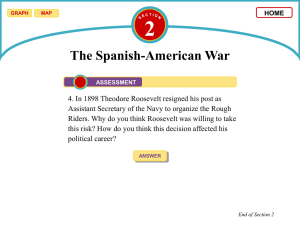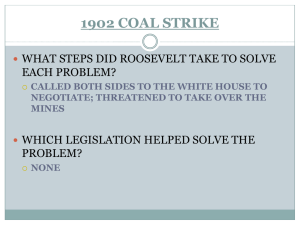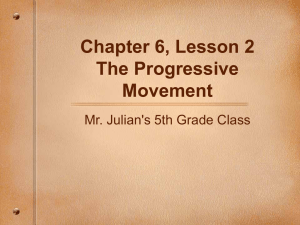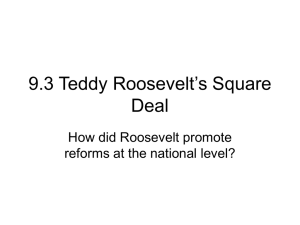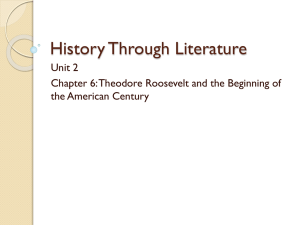LOC Camping Trip Lesson Plans
advertisement
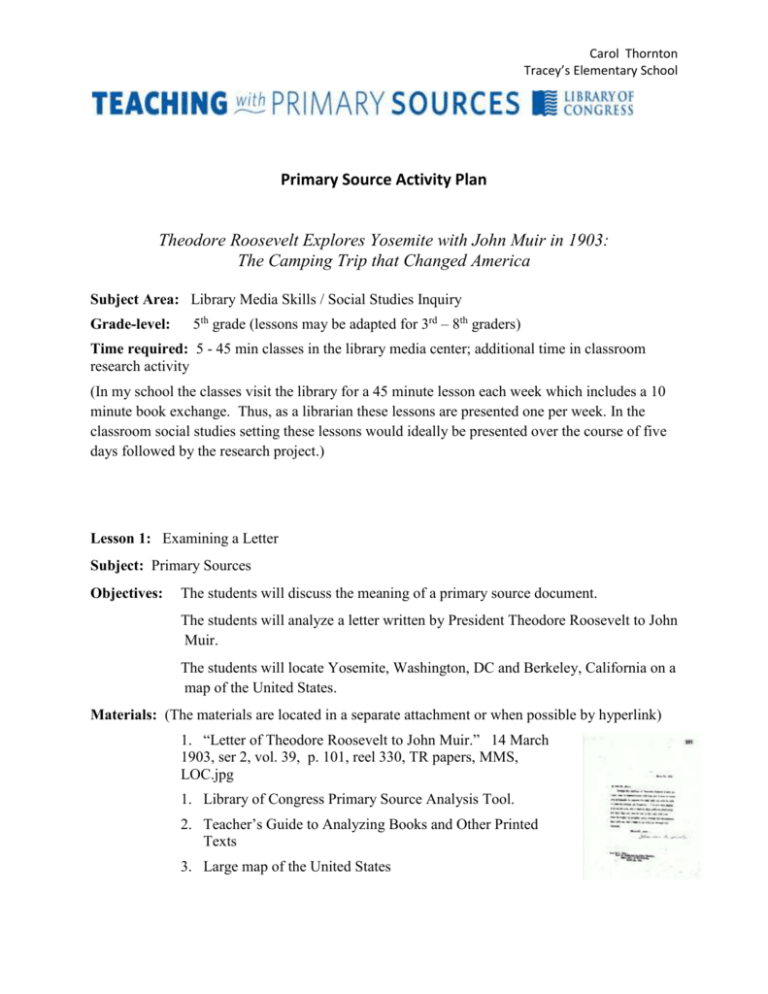
Carol Thornton Tracey’s Elementary School Primary Source Activity Plan Theodore Roosevelt Explores Yosemite with John Muir in 1903: The Camping Trip that Changed America Subject Area: Library Media Skills / Social Studies Inquiry Grade-level: 5th grade (lessons may be adapted for 3rd – 8th graders) Time required: 5 - 45 min classes in the library media center; additional time in classroom research activity (In my school the classes visit the library for a 45 minute lesson each week which includes a 10 minute book exchange. Thus, as a librarian these lessons are presented one per week. In the classroom social studies setting these lessons would ideally be presented over the course of five days followed by the research project.) Lesson 1: Examining a Letter Subject: Primary Sources Objectives: The students will discuss the meaning of a primary source document. The students will analyze a letter written by President Theodore Roosevelt to John Muir. The students will locate Yosemite, Washington, DC and Berkeley, California on a map of the United States. Materials: (The materials are located in a separate attachment or when possible by hyperlink) 1. “Letter of Theodore Roosevelt to John Muir.” 14 March 1903, ser 2, vol. 39, p. 101, reel 330, TR papers, MMS, LOC.jpg 1. Library of Congress Primary Source Analysis Tool. 2. Teacher’s Guide to Analyzing Books and Other Printed Texts 3. Large map of the United States Carol Thornton Tracey’s Elementary School Overview: Students will be introduced to the definition of primary sources though a whole group discussion. Then in cooperative pairs the students will analyze a letter written by President Theodore Roosevelt to John Muir requesting a visit to Yosemite with him. Procedures: Each lesson will open with the following established routine: Fifth grade students bring a folder to their library media class in which they record the drill and objective for their weekly lesson. This is a teaching tip picked up years ago during a Teaching American History grant program. It provides focus for the lesson and documents the students’ work throughout the year. This is particularly useful when lessons build on each other from week to week. Students are given time to discuss the answer to the drill with teacher input as needed. Then they record the answer in their folder. The objectives reflect the activity to be completed during the lesson. When their drill and objective are completed the students receive a sticker on their folder, which become quite decorated by the end of the year! 1. The students record the following drill in their media folder: “What is a primary source document?” 2. The students engage in a discussion relating what they already know about primary sources then record the definition provided by the Library of Congress in their folder: Primary sources are the raw materials of history – original documents and objects which were created at the time under study. 3. The teacher distributes one letter and the Library of Congress Primary Source Analysis Tool to each partner group. 4. The teacher may decide to explain to the students that the letter is blurry because of the method used to make duplicate copies. This letter was created before the days of carbon paper, photocopying, and computers. After the original letter was typed and signed on White House stationery, a damp piece of onion-skin like paper would be pressed on top of it, so that an impression of the content would transfer to the letterpress copy. 5. The teacher poses a few questions to provide focus for the reading of the letter: What do you think is the purpose of Roosevelt’s letter? How might Roosevelt’s goals to take a camping trip be similar or different from Muir’s? 6. The students work in cooperative pairs to read the letter. 7. Observations (list details from the text), reflections (create hypotheses about the text), and questions are recorded in the Library of Congress Primary Source Analysis Tool. 8. The teacher provides assistance as needed using the Teacher’s Guide to Analyzing Books and Other Printed Texts to help clarify the activity. 9. After working with their partner the students are given the opportunity to discuss their observations, reflections, and questions generated by this activity. Carol Thornton Tracey’s Elementary School 10. Challenge the students to locate Yosemite, Berkeley, California and Washington, DC on a large map of the United States. Notice the distance the letter must travel to reach John Muir. 11. The lesson will close with questions to think about generated by the students and posed by the teacher as needed. Some examples could include: How were letters delivered in 1903? How long would a letter take to get to California from Washington? Who was John Muir and why did Theodore Roosevelt want to go to Yosemite with him? What was special about Yosemite? What was Roosevelt’s purpose in visiting a wilderness area? Lesson 2: Examining Photographs Subject: Primary Sources Objectives: The students will create a list of types of primary source documents. The students will analyze a photograph of Theodore Roosevelt in Yosemite. The students will compare a photograph taken in 1903 with one taken in 2013. (or compare two photographs taken in 1903) Materials: 1. Theodore Roosevelt and John Muir on Glacier Point, Yosemite Valley, California, in 1903. http://www.loc.gov/pictures/item/93503130/ 2. President Roosevelt's choicest recreation - amid nature's rugged grandeur on Glacier Point, Yosemite http://www.loc.gov/pictures/item/2010647431/ Carol Thornton Tracey’s Elementary School 3 Photographs of Mrs. Thornton in Yosemite taken in 2013 4. Library of Congress Primary Source Analysis Tool 5. Teacher’s Guide to Analyzing Photographs and Prints Overview: Students will review the definition of a primary source document and brainstorm a list of types of primary source documents. Then, in cooperative pairs the students will analyze a photograph of President Roosevelt in Yosemite. Finally, the partners will compare and contrast the historic photograph with a photograph taken in the summer of 2013. (Comparing the two historic photographs is a suitable substitute for this portion of the lesson). Procedures: 1. The students record the following drill in their media folder: “Create a list of types of primary source documents.” 2. The students review the definition of primary sources learned the previous week: Primary sources are the raw materials of history – original documents and objects which were created at the time under study. 3. The students brainstorm types of primary source documents and create a list in their media folder. Some examples could include: letters diaries autobiographies newspaper articles political cartoons photographs paintings drawings laws 4. The teacher distributes one historic photograph and the Library of Congress Primary Source Analysis Tool to each partner group. 5. The teacher poses a few questions to provide focus for the photo analysis: What do you notice first? Why do you think this image was made? Who do you think was the audience for this image? 6. The students work in cooperative pairs to analyze the historic photograph. 7. Observations (descriptions of the image), reflections (hypotheses about the image), and questions are recorded in the Library of Congress Primary Source Analysis Tool. Carol Thornton Tracey’s Elementary School 8. The teacher provides assistance as needed using the Teacher’s Guide to Analyzing Photographs and Other Prints to help clarify the activity. 9. When the historic analysis is complete, the students are given an additional image taken near the same location (1903 or 2013 photograph) and a comparison chart. The students will record similarities and differences noted in the two photographs. 10. After working with their partner, the students will discuss observations, reflections, and questions generated by the image analysis activity. 11. The lesson will close discussing the students’ observations and questions. The students may ask why there are two seemingly identical photographs of Roosevelt placed side-by-side. Explain that these pictures would appear in 3-D when viewed through a stereo viewer. This was a popular form of photography in the late 1800’s and early 1900’s. As the students share the differences they noticed ask how these differences relate to the history of the National Parks. As an example, in the group photograph (2013) the people are sitting on a wall. Sidewalks, walls, hand rails, visitor centers and many other features have been constructed to make the National Parks assessable to all visitors. Also, have the students to think about the differences between taking a photo in 1903 vs. 2013. Consider the differences in the cameras and the audience each photographer had in mind. What “story” is each photo trying to tell? What do the photos tell us about Yosemite and the National Parks? Images of Roosevelt’s camping trip were published in newspapers with a national audience while I created a photo book to share with my travel group, family, friends, and students. Theodore Roosevelt explored the Yosemite wilderness returning with a determination to preserve these lands for future generations. Visitors today benefit from Roosevelt’s efforts. The students may debate the concept of preserving the wilderness versus making it easily assessable to crowds of people. For example, changes have been made in the accessibility of the trail to climb Half Dome. In the past there were no limitations on the number of visitors who could make this climb. (My group leader has ascended Half Dome over 80 times in his life). Today hikers must obtain a permit. The trail simply cannot accommodate the increasing number of people wanting to make this climb. The permits sell out in a couple of days for the entire year making the limited permits difficult to acquire. Carol Thornton Tracey’s Elementary School Lesson 3: Examining an Autobiography Subject: Primary Sources Objectives: 1. The students will be able to discern the difference between primary and secondary sources. 2. The students will analyze a selection from Theodore Roosevelt’s autobiography. 3. The students will draw on prior knowledge gained in previous lessons about Roosevelt’s visit to Yosemite to make connections with the autobiography excerpt. Materials: 1. “In Yosemite with John Muir.” Theodore Roosevelt, An Autobiography (1913). Excerpted from Chapter IX. Outdoors and Indoors. 2. Library of Congress Primary Source Analysis Tool 3. Teacher’s Guide to Analyzing Books and Other Printed Texts Overview: Students will review the definition of primary source documents and discuss the difference between primary and secondary sources. Then, the students will identify examples of each. Finally, in cooperative pairs the students will analyze an excerpt from President Roosevelt’s autobiography when the trip to Yosemite is fondly remembered. Procedures: 1. The students record the following drill in their media folder: “How is a secondary source different from a primary source?” 2. The students review the definition of primary sources learned from previous weeks. 3. The students engage in a discussion relating what they already know about secondary sources then record the definition provided by the Library of Congress in their folder: Secondary sources contain accounts or interpretations of events created by someone without firsthand experience. 4. The teacher will display a variety of nonfiction books on the topics of Roosevelt and Yosemite. Examples include: Theodore Roosevelt: the Adventurous President. Time for Kids Biography, 2005 Yosemite National Park. Margaret Hall, 2006. The Camping Trip that Changed America. Barb Rosenstock, 2012. 5. The students will identify the books as primary or secondary sources and defend their answers. (The books are all secondary sources. However, many historic photographs, primary sources, are located within these books providing a broader glimpse into Roosevelt’s life) Carol Thornton Tracey’s Elementary School 6. The teacher distributes the autobiography excerpt and the Library of Congress Primary Source Analysis Tool to each partner group. 7. The teacher poses a few questions to provide focus for the autobiography analysis: What new information do you learn in Roosevelt’s description of his trip with Muir? What surprises do you discover? What do you find out about John Muir and his particular interests? When was this document written? 8. The students work in cooperative pairs to read and analyze the autobiography. 9. Observations (descriptions of the text), reflections (hypotheses about the text), and questions are recorded in the Library of Congress Primary Source Analysis Tool. 10. The teacher provides assistance as needed using the Teacher’s Guide to Analyzing Books and Other Printed Texts to help clarify the activity. 11. After working with their partner, the students will discuss observations, reflections, and questions generated by the document analysis activity. 12. The students will recall new information gathered from the autobiography such as Roosevelt’s delight in seeing the Sequoias and hearing the songs of the birds. The fact that the camping trip lasted three days is also new information. Roosevelt was quite surprised that John Muir was not interested in birds! (This may surprise the students as well). Roosevelt recalled that the first night was clear and snow fell during the second night. 13. The students will discuss the purpose of Roosevelt’s autobiography as a means to record and inform the public about his life and thoughts. In noting the variety of ways people communicate today the students are sure to mention social media sites such as Facebook, email, instant messages, etc. 14. Other questions to think about may arise such as wondering about particular details of the trip (“What did the men eat?” or “Did they see any other wildlife?”) A larger question such as “How did Roosevelt help in creating the National Parks?” would require further investigation. Carol Thornton Tracey’s Elementary School Lesson 4: Examining a Newspaper Article Subject: Primary and Secondary Sources Objectives: 1. The students will analyze a selection from a newspaper article describing Roosevelt’s trip to Yosemite. 2. The students will present a summary of their selection in a Jigsaw manner to the whole class. 3. The students will draw on prior knowledge gained in previous lessons about Roosevelt’s visit to Yosemite to make connections with the newspaper article. 4. The students will describe the similarities and differences in the multiple accounts of Roosevelt’s trip to Yosemite examined in the lessons including the particular perspective of each document. Materials: 1. "President Makes Camp at Bridal Veil Falls," The Call (San Francisco, CA), May 18, 1903, Page 1, Image 1, col. 5-7. 2. Library of Congress Primary Source Analysis Tool 3. Teacher’s Guide to Analyzing Books and Other Printed Texts Overview: The newspaper article will be divided into five selections. Each table group will receive one selection to analyze and report back to the class a brief summary as well as their observations, reflections, and questions. Using the jigsaw approach transforms a challenging article into a manageable assignment. Procedures: 1. The students record the following drill into their folder: “How is a newspaper article different from the other primary sources examined?” 2. Allow the students to comment on the question relating differences such as the newspaper reporter writes the article from his/her perspective. The reporter does not have firsthand experience with the overnight camping experience itself but is relating the news through Roosevelt’s brief speech to a crowd in Yosemite Valley. 3. Show an enlarged copy of the entire newspaper article to the class and have the students share their initial observations. The students will notice the newspaper headline, the photo of Roosevelt on a horse, the date, and possibly the price of the newspaper. 4. Then, distribute a selection from the newspaper article to each table group to analyze in greater detail along with the Library of Congress Primary Source Analysis Tool. Carol Thornton Tracey’s Elementary School 5. Remind the students to record their observations, reflections, and questions on the form. Students may work with their cooperative pair or as an entire table group (4 – 5 students) 6. The students need to note the main ideas and interesting new details in their selection in order to present a brief summary to the class. 7. Return to whole group instruction allowing enough time for each table group to present their summary. Students may record additional observations, reflections, and questions as they listen. 8. If time is short each table group can present one interesting new detail learned such as Roosevelt shaved by the light of a campfire, camped in a snowstorm without a tent, and traveled with two park rangers (as well as John Muir). 9. Close the class with the questions the students are wondering about. Remind the students that next library class we will read the picture book, The Camping Trip that Changed America. Some of their lingering questions should be answered in this read aloud. Lesson 5: The Camping Trip that Changed America Subject: Maryland Black-Eyed Susan Picture Book / NSCC Notable Social Studies Trade Book Objectives: 1. The students will identify the primary and secondary sources in the picture book bibliography. 2. The students will make predictions about what will be included in this picture book account of Roosevelt’s trip to Yosemite with John Muir. 3. The students will identify specific locations using prior knowledge obtained from the primary source analysis activities. Materials: The Camping Trip that Saved America: Theodore Roosevelt, John Muir and our National Parks Overview: The students will examine the bibliography and determine which documents are primary and which are secondary sources. The students have experienced “thinking like a historian” and can relate their experiences to those of an author creating a nonfiction book. The picture book will be read to the class followed by a discussion. Were questions posed in the previous lessons answered in this book? Procedure: 1. Project the bibliography so the class can view as a whole group. Have the students identify the sources used in creating this picture book and classify then as primary or secondary sources. “Great Reception for President Roosevelt,” Oakland Tribune, May 29, 1903 Newspaper article – Primary source Hata, Donald. With Theodore Roosevelt and John Muir in Yosemite. Los Angeles: Western Brand Books, 1974 Carol Thornton Tracey’s Elementary School Nonfiction book – Secondary source Leidig, Charlie. Report of President Roosevelt’s Visit in May, 1903, Yosemite Library, unpublished. Firsthand account – Primary source Muir, John. The Eight Wilderness Discovery Books. Seattle: The Mountaineers, reprinted 1992. Firsthand account – Primary source “Roosevelt Pitches his Camp near Bleak Sentinel Dome in Snow Storm,” San Francisco Chronicle, May 17, 1903. Newspaper article – Primary source 2. Continue the discussion by asking the students if the picture book is a primary or secondary source. Think about how the author created the book by reexamining the bibliography. Most of her research involved primary sources and one can infer from Leidig’s unpublished report that Rosenstock actually visited Yosemite and used the library there. 3. Before reading The Camping Trip that Changed America the students will offer predictions of events they know occurred on this trip and think should be included in the book. 4. Direct the students to think about the questions they had posed during the document analysis activities and to listen for answers to these questions. 5. Read the book aloud to the class. Stop for discussion as needed especially when students provide insights from their primary source analysis activities. The students should be able to identify Glacier Point and will most likely enjoy the camping in the snow description. Roosevelt expresses great joy and relates this experience as one of the most pleasurable in his life. 6. Conclude with a discussion of new information learned from listening to the picture book. Were questions answered or further questions generated? How did the personal experiences and interests of President Theodore Roosevelt’s camping trip shape his policies about preserving our nation’s wilderness areas?

